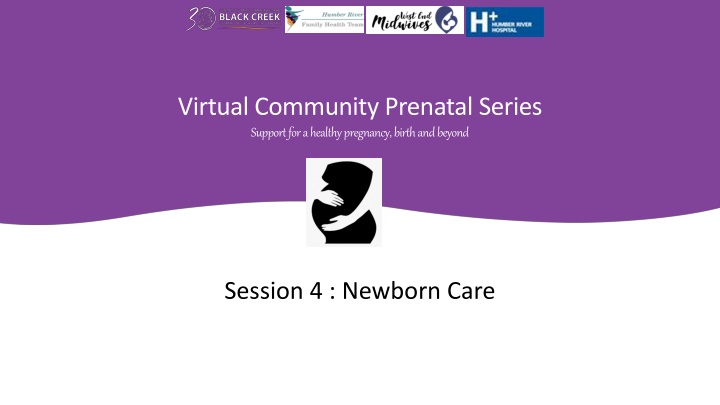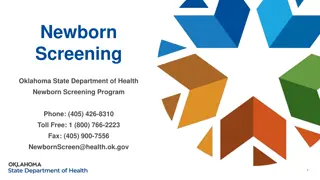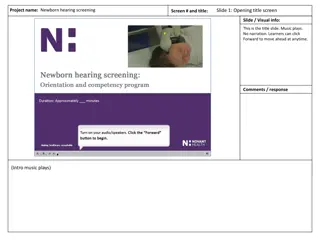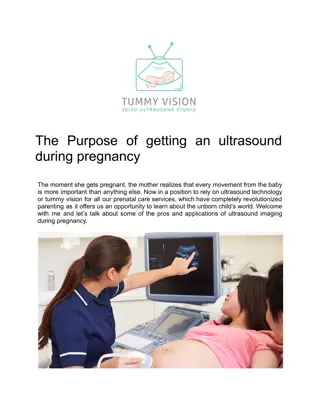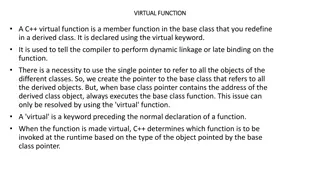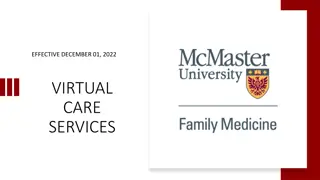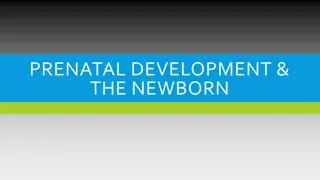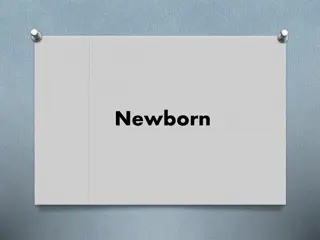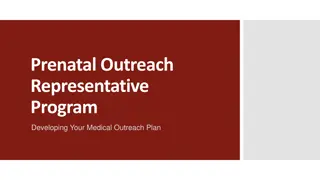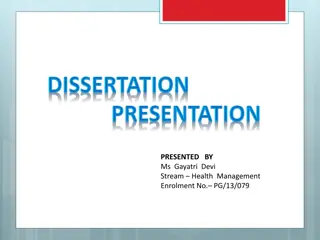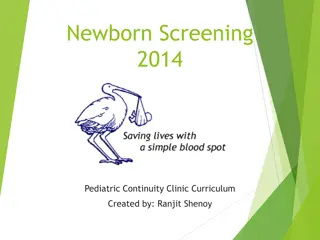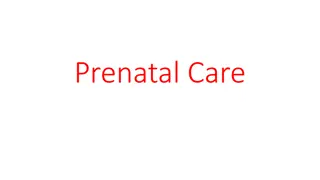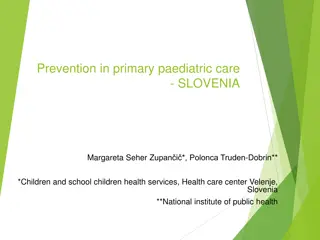Virtual Community Prenatal Series Session 4: Newborn Care and Going Home Preparation
Explore newborn care essentials and tips for going home from the hospital with your baby. Learn about normal newborn behaviors, breathing patterns, and when to seek help. Discover important considerations such as feeding, sleep arrangements, and community resources for parents.
Download Presentation

Please find below an Image/Link to download the presentation.
The content on the website is provided AS IS for your information and personal use only. It may not be sold, licensed, or shared on other websites without obtaining consent from the author.If you encounter any issues during the download, it is possible that the publisher has removed the file from their server.
You are allowed to download the files provided on this website for personal or commercial use, subject to the condition that they are used lawfully. All files are the property of their respective owners.
The content on the website is provided AS IS for your information and personal use only. It may not be sold, licensed, or shared on other websites without obtaining consent from the author.
E N D
Presentation Transcript
Virtual Community Prenatal Series Support for a healthy pregnancy, birth and beyond Session 4 : Newborn Care
Disclaimer Description We use video and audio technology so we can see and hear each other. We recommend you be in a quiet place so that others cannot overhear the session (unless you want to include others in your visit please tell us who is with you). Details of your attendance only will be noted in your record. We will not make an audio recording of the group program. We ask that you not record either Privacy We have taken appropriate steps to protect your privacy for this group program (paid Zoom business account) We cannot provide you with the same guarantee of security and confidentiality as if the program were being run in-person. Our presenters who are doing the group program may be working from the clinic or from home because of the pandemic. If working from home, they will use a private space away from others Risks It is possible there could be a problem with the technology and your session could be cut short or interrupted. The quality of the video or audio may vary depending on your own connection.
What are the question that cross your mind as a parent, when you will be taking your baby home for the first time?
Going home from hospital Bringing baby home from hospital - Most well babies discharged from the hospital in 24 hours, some may need to stay back. - Questions to consider before the baby is born - Baby feeding - Sleep arrangements - Preparing pets, siblings for new baby - Kind of diapers to use - Developing an understanding of normal newborn behavior - Developing an understanding of normal care plan for a well baby - Developing an understanding of community resources for parents
Managing normal newborn care What is Normal newborn behavior ? Newborn behave a little differently than older babies and children as they transition into their life outside the womb. When do I need to seek extra help? Therefore it is good to know what is normal for a newborn behavior and how to identify signs that require additional help or indicate illness
How many times does a baby breathe in one minute? - 16-20 - 40-60 - 80 - 90
Newborn Breathing Pattern Baby may breathe irregularly in clusters. Baby may at times appear to be breathing shallow and rapidly. Sometimes the baby may breathe deeply and slowly. Normal rate of breathing in newborn is 40-60 per minute. Babies may pause their breathing for about 10 seconds and then resume with a deep breath. It is not normal for babies to gasp for breath or breathe quickly for more than 10 minutes. It is normal for a baby to cough up as if trying to clear the throat. They may also have some bubbles at their mouths.
Seek help if Baby s breathing stops for more than 10 seconds Baby s nostrils widen as he or she breathes for longer than few minutes ( called Nasal flaring ). The skin around the baby s ribs and at the base of the throat pulls in sharply with each breadth ( called in-drawing ). Baby makes grunting sounds with each breath: this lasts longer than a few minutes. https://www.youtube.com/watch?v=IECGJiEyqFQ
Normal newborn behavior -Colour Pink face and chest is normal, means baby is well. Baby may get Blue/Purple hands or feet in the first 24 hours May get blotchy and red when cold or crying May have mild Jaundice (yellow in face) after 24hours. Anytime the baby becomes blue in the face and chest then its time to call for 911.
Normal newborn -Temperature Normal temperature range for a newborn is 36.5 C to 37.5 C (97.7 F 99.5 F) No need to take temperature on a fixed schedule only when baby feels too hot or cold or has other symptoms of illness. https://www.youtube.com/watch?v=WlzjkHdd1IU Baby needs just one layer more than you, if you are comfortable to sleep in the room temperature so is the baby. Overheating a baby is associated with SIDS, therefore as a part of safe sleep baby sleeps in the fitted sleeper. If baby needs an additional blanket then it should be thin breathable one.
Approximately how many times does a baby eat in one day? - 3 times on a schedule - Every 2 hours - On demand
Normal newborn behavior -Feeding Babies eat a lot After the first 24 hours baby should eat every 2 -4 hours, approximately 8-12 times in a day. Baby usually feed for about 20min or longer and then a satisfied baby will detach from the nipple after finishing a feed. Baby may cluster feed and then have a longer stretch without feeding https://www.youtube.com/watch?v=fgcWOzauLxI
What does a baby poo look like ? - Black green - Brown - Yellow
Normal newborn behaviour - Elimination It tells us if baby is eating well Wet diapers Day 1 = 1 wet diaper Day 2 = 2 wet diaper Day 3 = 3 wet diapers Bowel Initially babies have meconium ( dark-greenish sticky stools ) for first couple days this then changes to transitional stools ( dark- green/Brownish with speck of yellow) then to yellow runny stools as the breast milk transitions to mature milk.
Normal newborn - Cord care The piece of the umbilical cord left behind may have a clamp on it. The normal care for this cord is to leave it open to air, don t cover it with the diaper. Just sponge it dry after a baby bath. As it gets ready to fall of in the first week usually, it may begin to look dry and wrinkled and a small amount of blood or discharge may come off on your baby s clothes. This is normal. It may also have a strong smell, this is normal. If the skin around the cord becomes red and infected looking then you need to seek help asap.
Normal newborn care - Muscle tone Newborn needs to be supported when held especially the newborn head. Newborn should not feel completely limp in your arms. Baby should display strong well-flexed movements of his or her arms and legs. Newborns head needs to be supported at all times.
What care is provided to babies at birth by the providers? - Monitoring their vitals i.e. heart rate, breathing etc - Physical exam - Giving medications
Normal Newborn Health care What is a newborn physical exam Baby medications Routine baby healthcare checks Immunizations
Cradle cap Cradle cap is the oily yellow scaling or crusting on the baby s scalp. This is not an illness. It is caused by normal build up of sticky skin oils, scales and sloughed skin cells. It does not mean that baby is not well cared for. It is not harmful to baby and goes away before first birthday.
Crying and Colic Healthy babies cry, crying is a way to communicate their needs. Even the most well cared for babies will sometimes be difficult to soothe, remember its not your fault. When a baby cries long and hard (without break)even though the baby has been fed, changed and cuddled baby is said to be Colicky . Colic is a normal part of babies development
Managing a crying baby Check to see if baby needs something a diaper change, a feed, is too hot or cold, or has a fever. Hold your baby and comfort your baby, you wont spoil them. Wrap or swaddle a baby Turn off light and keep surrounding quiet too much stimulation can sometimes cause this. Soft music, gentle shushing noise can soothe some babies. Many babies can be soothed by motion try walking, rock or sway with baby in gentle rhythmic motion. Try going for a ride in the car.
Managing a crying baby contd Sucking sometimes helps calm babies encourage breastfeeding or suckling on a finger. Give your baby a warm bath. There is little scientific evidence to support the effectiveness of medicine or probiotics. REMEMBER - NEVER SHAKE YOUR BABY
Prepare for parental relief Planning for regular child care relief is important - Taking care of a newborn baby can be hard and a baby s constant cry can be stressful. -Eating and sleeping well is important try getting at least 3 hours of sleep in a row twice a day -Parents need relief, take sometime for self care and exercise, read or enjoy a visit with a friend. -Occasionally, you may have negative thoughts, its OK as long as you do not act on them. Be aware of Post partum depression, if you feel depressed , resentful and angry, talk to some one. -Seek help for community resources from your healthcare providers.
Dry skin and skin care - Normally, newborn skin is soft and smooth, sometimes it may be wrinkled and peeling in the first few days after the birth. - Feel free to give your newborn a gentle massage with any edible oil. Milia Tiny raised white spots - You may find these raised white spots on your baby s face, they are just plugged oil glands caused by pregnancy hormones. They clear up within 3-4 weeks. Do not pop or remove them. Newborn rash They re blotchy with tiny pinpoints, found anywhere on body, in the first few months after birth. They are normal.
When to seek care for rashes? When they become red inflamed oozing fluid or have yellow raised spots in them this could be infection.
Baby Nail care Keep the baby nails trimmed to prevent scratches. - Use blunt scissors or emery board to cut or file your baby s nails. Gently file the corners - The best time to trim the baby s nails is when your baby is asleep or sleepy and the hands are open and still. - https://www.youtube.com/watch?v=w-OMcXNebgE
Newborn Jaundice It is normal for baby to have mild Jaundice ( yellow face) after 24 hours. This is called Physiological jaundice. When to seek help with Jaundice - when it develops within the first 24hours - When it continues to increase. - When the baby is not feeding well, not waking up to feed and is sleepy or does not have enough wet diapers.
Newborn sleep-wake cycles Newborn spends their time in different states in early days or weeks, deep sleep, light sleep, quiet alert, active alert, crying. Newborns sleep for about 16hrs a day, but the pattern is unpredictable. As the baby grows the baby becomes more alert and keeps awake for longer periods of time In the first few days your baby should sleep for no longer than stretches of 4-6 hours without waking up to feed. If the baby has been sleeping for a long time then try to wake them up and feed them. Some babies are difficult to wake, try to undress put them on the chest or change their diaper or talk to them to wake them up. Try again after half an hour or wipe a cool cloth on their face to help wake them. After waking baby may take sometime to latch its normal.
Contd.. If the baby is unusually sleepy or difficult to arouse and uninterested in feeding after waking even after 4 -6 hours probably seek some help.
What is the risk to a baby during sleep? https://www.youtube.com/watch?v=09kNXxYB_Ko&t=399s
Safe sleep environment for babies Babies should always be put to sleep on their back. Tummy time 2-3 times a day, soon after birth, helps develop muscles and prevents flat head. Safest place for a baby to sleep is the crib, cradle or bassinet that meets the safety regulations. - Bassinet until the baby can roll over or the weight limit by manufacturer - Crib until baby can crawl out of it or is taller than 90cm. A firm mattress with a fitted sheet and baby sleeps in the fitted baby sleeper. No soft toys loose clothes, blankets, etc in the crib. If a blanket is needed it should be thin, lightweight, breatheable material.
Following practices decrease the chances of SIDS- Sudden infant death syndrome. Smoke free environment before and after the birth. Exclusive breastfeeding. Place the baby on his or her back to sleep. Firm surface with no pillows, comforters, quilts or bumper pads. Crib, cradle or bassinet Next to your bed Room sharing Fitted one piece sleepwear, no extra blankets
What does a parent need to be mindful of to ensure safe bath for the baby? - Burns - Slip and fall - Loosing body heat - Leisurely fancy bath
Baby bath safety Preventing Burns - Set your hot water heater thermostat at 49 C or lower. - Turn on cold water first and then hot water and when tub is full turn off hot water first and then cold water. - Check the temperature of the water on your wrist or elbow, before using it on your baby.
Baby bath safety Prevent drowning or injuries Infant bath seats and bath rings associated with a risk of drowning. Bath baby in the sink, a basin, a baby bathtub, or in a bathtub with an adult. Supervise baby during bath, keep them in sight within an arm s reach. If you leave the room take the baby with you. Remove jewelry that could scratch your baby. Apply Edible oils after the bath, to prevent slip and fall.
Baby bath safety Prevent loosing temperature for baby - Undress the baby when the tub is ready. - Have everything within easy reach before you start. - Lay out a towel next to the sink, basin, or tub to lay your baby on after the bath. - Pat the baby dry with the towel clean, remember the skin folds. - Have clothes ready to dress.
Baby bath safety Face and eyes - Just clean with water no soap needed. - Each eye from inwards to outer corner of the eye. - No Q tips in baby ears, nose or eyes. - Wipe the external ear with a soft washcloth. - Wipe baby gums with a soft clean cloth.
Car seat safety Car seats - Rear facing, appropriate seat - Secure properly, snug fit to baby - No padding, blankets or clothes between the seat and baby - Strap well to the car seat - https://www.youtube.com/watch?v=iMctMVcuG0w- putting your child in the car seat https://www.youtube.com/watch?v=IIZW_SvVWT8- installing the seat
Diapers - what kind of diapers to use - how to diaper a baby
Swaddling and wrapping a baby Safe swaddling of the baby - Ensure the air passages are not obstructed - Use light blanket - Enough room to flex or extend feet - Stop swaddling when baby starts to roll over https://www.youtube.com/watch?v=qjUhHFNLZdw
Birth registration and parenting support Birth registration online or paper application at Service Ontario. Social insurance number Canada child tax benefits Registered Education Savings plan
